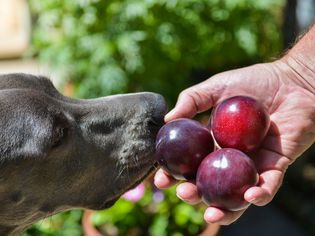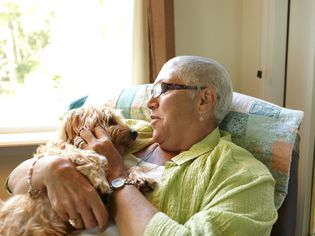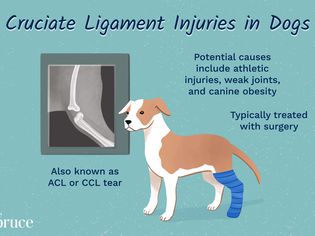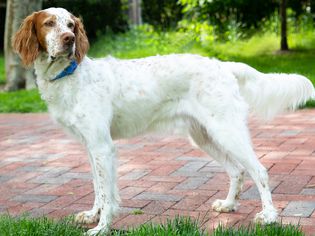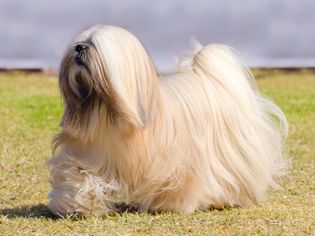The Spanish Galgo is a medium-size hound dog breed from Spain with a short, smooth or rough coat and a narrow, lanky build. Also known as the Spanish greyhound or Galgo Español, these dogs closely resemble the more common English greyhound dog breed—likely a relative of them.
Galgos are athletic, with good swiftness and endurance. But they don’t require an excessive amount of exercise and are typically calm in the house. They can make for very gentle and loving companions.
Learn all about the Spanish Galgo, from their temperament to their care needs and more.
Breed Overview
Group: Hound
Height: 23.5 to 26.5 inches (females); 24.5 to 27.5 inches (males)
Weight: 50 to 55 pounds (females); 60 to 65 pounds (males)
Coat: Short, smooth or rough
Coat Color: Any color; usually fawn, brindle, black, chestnut, cinnamon, red, or white with/without white markings
Life Span: 12 to 15 years
Temperament: Friendly, calm, even-tempered
Hypoallergenic: No
Origin: Spain
Characteristics of the Spanish Galgo
The Galgo generally has a laid-back personality and is friendly with people, including children. Galgos also typically get along with other dogs and sometimes cats, but they might view smaller animals as prey.
A moderate energy level also helps to shape this breed’s temperament, making this a good dog for those who like to be active but also curl up on the couch.
| Affection Level | High |
| Friendliness | High |
| Kid-Friendly | High |
| Pet-Friendly | Medium |
| Exercise Needs | Medium |
| Playfulness | Medium |
| Energy Level | Medium |
| Trainability | Medium |
| Intelligence | Medium |
| Tendency to Bark | Low |
| Amount of Shedding | Medium |
History of the Spanish Galgo
The Spanish Galgo breed can trace its ancestors thousands of years back, potentially to ancient African, Asian, and European sighthound breeds. Images of these types of dogs have been documented in Spain since around the 10th century.
They were highly prized for their hunting abilities, making the dogs a favorite among the nobility. Ancient Spanish artwork also depicts Galgos hunting with their owners. The Galgo is even mentioned in the famous Spanish novel “Don Quixote.”
Spanish Galgos remain rare around the world today. The United Kennel Club first recognized the Galgo in 2006. The American Kennel Club does not yet recognize the breed.

Spanish Galgo Care
Meet a Galgo's exercise needs each day, and they usually will be an easygoing household companion. Grooming is fairly easy for this dog. And training and socialization should ideally begin at a young age.
Exercise
Plan to spend at least one to two hours each day exercising your Galgo via activities like:
- Long walks
- Running
- Hiking
- Cycling
- Vigorous games of fetch
- Dog sports, such as tracking
Puzzle toys can help your dog burn some mental energy.
It’s ideal that a Galgo has a securely fenced area where they can run freely at their own speed to burn energy. But avoid letting a Galgo off leash outside in an unfenced area, as their hunting instincts might kick in and cause them to take off chasing perceived prey.
Moreover, the short coat of a Galgo doesn’t provide much protection against cold weather. So consider a dog coat or sweater in the cold, and try to keep outdoor sessions relatively short.
Grooming
Galgos only require basic grooming. Brush weekly to remove loose fur either with a soft-bristle brush or grooming mitt. You might notice an uptick in shedding in the fall and spring, during which you’ll have to brush more frequently.
Plan on a bath around every month, depending on how dirty your dog gets. Trim your dog’s nails roughly every month as well. And check their ears at least weekly for wax buildup, debris, and irritation. Finally, aim to brush their teeth every day.
Training
It’s best to begin training and socialization when your Galgo is a puppy to instill good manners. Galgos tend to respond well to positive training techniques; harsh corrections can cause this sensitive breed to shut down and refuse to learn. Put some extra focus on recall training, so you’ll ideally be able to call your dog back if it begins to chase perceived prey.
Galgos can be shy and reserved around strangers, though they don’t have a tendency toward aggression. Try to give your dog lots of positive experiences around different people and in various places to help boost its comfort and confidence.
Common Health Problems
Because Galgos are rare, not much is known about the breed's potential hereditary health issues. But these dogs can be prone to some of the same issues that are also often seen in greyhounds and other sighthounds, including:
- Osteosarcoma: This is a type of bone cancer in dogs. Symptoms include lameness, localized swelling, and muscle loss.
- Bloat and gastric torsion: Known as gastric dilatation-volvulus (GDV), this is a potentially fatal emergency that needs veterinary care right away. It happens when the dog’s stomach fills with food, fluid, or gas and twists.
- Anesthesia sensitivity: Some dogs may be at greater risk of adverse effects from anesthesia. Discuss this with your veterinarian if your dog needs surgery.
- Heart problems: Cardiac conditions in dogs include dilated cardiomyopathy (DCM) and valve disease. Veterinary checkups can help detect these problems.
- Eye problems: Dogs can have various eye problems, such as eye infections, progressive retinal atrophy (PRA) that can lead to blindness, and cataracts that can reduce vision.
Diet and Nutrition
Always have fresh water available for your Galgo. Feed them a high-quality canine diet that’s nutritionally balanced. Always discuss both the type of diet and the amount with your vet.
It’s typical to feed two measured meals per day. But Galgos can be prone to bloat and potentially life-threatening stomach twisting if they eat too quickly. So you might want to feed smaller, more frequent meals or use a special feeder that slows down their eating. Also, avoid exercising your dog right before and after a meal.
Where to Adopt or Buy a Spanish Galgo
The Spanish Galgo is a rare dog breed, especially in North America. It is difficult to find a reputable breeder, and you likely won’t find a Galgo at a local animal shelter.
There has been much controversy over hunters in Spain abusing Galgos and then leaving them to die once they’re no longer useful. Rescue organizations worldwide have attempted to intervene in this and save the dogs. So it is possible to adopt a Galgo in need through one of these organizations, including:
- Galgos Del Sol
- Galgo Rescue International Network
- SAGE (Save a Galgo Español)
- 112 Carlota Galgos
Spanish Galgo Overview
Though they may be hard to locate, Spanish Galgos make great pets that are loyal and fun. These dogs are best for those who have a securely fenced yard for running and playing. Also, bear in mind that they have a high prey drive—something to think about if you have other pets.
Pros of Spanish Galgos
- Typically gentle and loving
- Can be a good family pet
- Doesn't need a high amount of exercise
Cons of Spanish Galgos
- High prey drive
- Doesn't tolerate cold well
- Difficult to find a breeder or rescue group
More Dog Breeds and Further Research
As with any breed, if you’re interested in the Galgo be sure to do plenty of research to verify that they will fit with your lifestyle. Talk to breed owners, rescue organizations, reputable breeders, and veterinary professionals. Try to spend some time around Galgos, too, if possible.
If you’re interested in similar breeds, check out:
- Greyhound
- Basenji
- Saluki
There’s a whole world of potential dog breeds out there—with a little research, you can find the right one to bring home!
- What's the difference between a Spanish Galgo and a greyhound?
The Galgo and greyhound look quite similar at first, and they have comparable temperaments. But the Galgo is generally a little smaller with a less deep chest, and their tail and head are a little longer than a greyhound’s.
Are Spanish Galgos rare?The Spanish Galgo isn't a common dog breed to find, especially outside of Spain. But there are rescue organizations that work to save unwanted Galgos from abusive situations, so it’s possible to find a Galgo through one of them.
Are Spanish Galgos good family dogs?Well-trained and socialized Spanish Galgos can be excellent family dogs. They are typically even-tempered and patient even around rambunctious kids, though any dog should be monitored around young children.
Related Article



